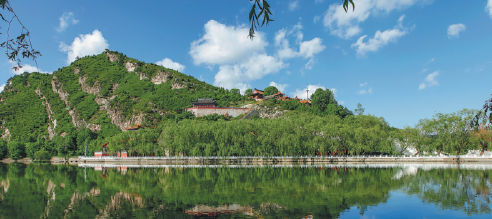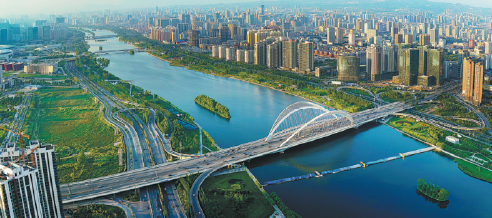
Originating from the Guancen Mountain in Ningwu county, the 716-kilometer Fenhe River is the mother river of Shanxi. [Photo by Cao Jianguo for China Daily]
The 716-kilometer-long Fenhe River in Shanxi has been a symbol of the province for thousands of years.
Running through 29 counties and districts of six cities, the river is the second-largest tributary of the Yellow River.
Since residents began using the Fenhe to irrigate farmlands on both banks more than two millennia ago, the river has played an important role in nurturing the local economy and culture.
However, with the development of an economy reliant on coal mining and heavy industries, the river has suffered severe pollution over recent decades.
Local authorities' recent efforts in shifting its economy toward high-quality and environmentally friendly growth have given new vitality to the river, once again making it an attraction in the province.
In Taiyuan, the provincial capital of Shanxi, the river runs through the city from the north to the east and acts as a greenbelt.
With shaded paths, long cycleways and parks, riverside areas have become an attractive destination for sightseeing, relaxing and recreation.
Wang Fang, a local resident, is a frequent visitor to the river's banks. She likes to walk slowly along the river and take pictures of the landscape.
"As a huge sightseeing belt is developed along the river, I visit here almost twice a day-doing exercise in the morning and taking a walk in the evening," Wang said.
Yang Wei, a cycling enthusiast, described the changes he had seen at the river over the decades.
"The Fenhe River area was an unpleasant place some 20 years ago.
"It smelled badly as garbage was littered and wastewater was discharged into the almost-dry river. As there were no trees and grass along the river, the area was often covered in dust in springtime.
"Nobody would like to cycle or walk along the river," Yang said.
But then it began to improve at the end of the 1990s. The most radical changes took place three years ago.
"Now, there is more water in the river. The water is clean, the sky is blue and the air is fresh," Yang said.

After decades of environmental protection efforts, the Fenhe River is now a major attraction in Taiyuan city. [Photo by Shi Zhiyong for China Daily]
According to local officials, the government began its river-cleaning program in 1998.
Chen Erdong, board chairman of Taiyuan Water Utilities Group, said:"As polluting enterprises were shut down and more projects were built for solid waste and wastewater treatment, the pollution of the river was effectively curbed in 2017."
In that same year, the city government began a greening and landscaping project for the river.
"At present, the average width of water in the river is about 300 meters. And there are two 150-mwide greenbelts on both banks,"Chen said.
He noted that the greenbelts are composed of trees, grasses and aquatic plants, which offer a habitat for more than 150 species of bird.
Now that the main waterway of the Fenhe has improved substantially, Chen said Taiyuan's new initiative is to improve the environment of its nine tributaries in the city.
Zhang Pengcheng, a cleaner working on the greenbelts, said what impressed him most is the growing awareness of environmental protection among visitors and residents.
"As more and more people stop littering, my job now becomes much easier.
"Having worked here for more than 10 years, I feel I am falling in love with the river," Zhang said.
Guo Yanjie contributed to this story.
